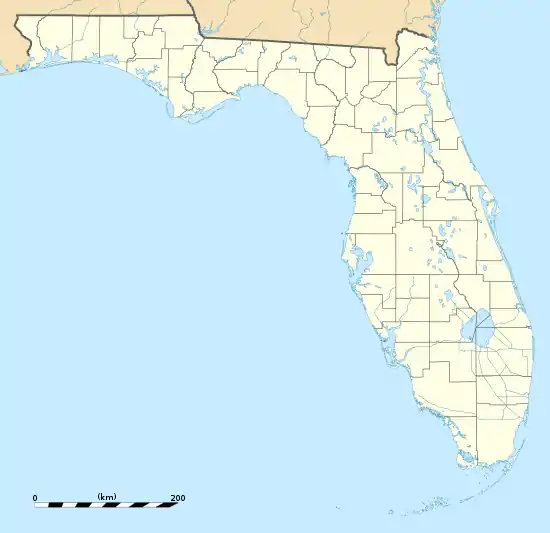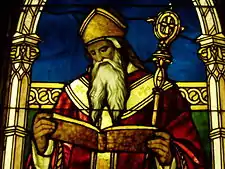Lightner Museum
The Lightner Museum is a museum of antiquities, mostly American Gilded Age pieces, housed within the historic Hotel Alcazar building in downtown St. Augustine. This 1887 Spanish Renaissance Revival style building is listed on the National Register of Historic Places.
Alcazar Hotel | |
 The Lightner Museum, originally the Alcazar Hotel, with a statue of Pedro Menéndez de Avilés on the ground. | |
  | |
| Location | 75 King Street St. Augustine, Florida |
|---|---|
| Coordinates | 29°53′30″N 81°18′51″W |
| Built | 1887 (museum opened 1948) |
| Architect | Carrère and Hastings |
| Architectural style | Spanish Renaissance Revival[1] |
| Website | www |
| NRHP reference No. | 71001013[2] |
| Added to NRHP | February 24, 1971 |
History
Hotel Alcazar
The hotel was commissioned by Henry Flagler, to appeal to wealthy tourists who traveled south for the winter on his railroad, the Florida East Coast Railway. It was designed by New York City architects Carrère and Hastings, in the Spanish Renaissance Revival style. The firm also designed the Ponce de León Hotel across the street, now part of the campus of Flagler College. Both structures are notable for being among the earliest examples of poured concrete buildings in the world. These architects later designed the New York Public Library in New York City and the Russell Senate Office Building in Washington, D.C.
The hotel had a steam room, massage parlor, sulfur baths, gymnasium, a three-story ballroom, and the world's largest indoor swimming pool; however, after years as an elegant winter resort for wealthy patrons, the hotel closed in 1932.
On August 20, 1947 Chicago publisher Otto C. Lightner purchased the building to convert the old hotel into a hobbies museum. He used the space to house several collections, including his own extensive collection of Victorian era art.[3][4] He then turned it over to the city of St. Augustine and the museum opened to the public in 1948.[5]
The building is an attraction in itself, centering on an open courtyard with palm trees and a stone arch bridge over a fishpond.
Museum
The museum occupies three floors of the former Hotel Alcazar and is housed in the former health facilities of the hotel, including the spa and the Turkish bath, in addition to its three-story ballroom.
The first floor of the museum houses a Victorian Science and Industry Room displays shells, rocks, minerals, and Native American artifacts in beautiful Gilded Age cases, as well as stuffed birds, a small Egyptian mummy, a model steam engine, elaborate examples of Victorian glassblowing, a golden elephant bearing the world on its back, and a shrunken head. Moreover, the first floor contains a music room, filled with mechanized musical instruments—including player pianos, reproducing pianos, orchestrions, and others—dating from the 1870s through the 1920s. It formerly featured a Victorian village, with shop fronts representing emporia selling period wares; this area is now the gift shop.
The second floor contains examples of cut glass, Victorian art glass and stained-glass work from Louis Comfort Tiffany's studio. The third floor, in the ballroom's upper balcony, exhibits paintings, sculptures, and furniture, including a grande escritoire created for Louis Bonaparte, Napoleon's brother and King of Holland between 1806 and 1810. The Ballroom Gallery has oil paintings by Paul Trouillebert (Cleopatra & the Dying Messenger), Léon Comerre (Maid of Honor), and Albert Bierstadt (In the Yosemite). It also has sculptures by Jean-Baptiste Carpeaux and Randolph Rogers.
On view from the ballroom's upper balcony is the now drained swimming pool. The pool now hosts the Cafe Alcazar.[6][7]
Gallery
 Tower detail of the Lightner Museum
Tower detail of the Lightner Museum Taxidermic bird (detail) at the Lightner Museum
Taxidermic bird (detail) at the Lightner Museum Shrunken head exhibited at the Lightner Museum
Shrunken head exhibited at the Lightner Museum Louis Comfort Tiffany stained-glass window of St. Augustine, exhibited at the Lightner Museum
Louis Comfort Tiffany stained-glass window of St. Augustine, exhibited at the Lightner Museum Historical marker
Historical marker
References
- Ossman, Laurie; Ewing, Heather (2011). Carrère and Hastings, The Masterworks. Rizzoli USA. ISBN 9780847835645.
- Lightner Museum. "Lightner Museum" brochure, circa 2007.
- "National Register Information System". National Register of Historic Places. National Park Service. July 9, 2010.
- "Archived copy". Archived from the original on 2019-03-26. Retrieved 2019-08-19.CS1 maint: archived copy as title (link)
- "Archived copy". Archived from the original on 2019-08-19. Retrieved 2019-08-19.CS1 maint: archived copy as title (link)
- http://staugustine.com/history/lightner-museum
- "Archived copy". Archived from the original on 2019-08-19. Retrieved 2019-08-19.CS1 maint: archived copy as title (link)
- "Archived copy". Archived from the original on 2019-08-19. Retrieved 2019-08-19.CS1 maint: archived copy as title (link)
External links
 Media related to Lightner Museum at Wikimedia Commons
Media related to Lightner Museum at Wikimedia Commons- Official website
- "Florida's Smithsonian"
- Historic American Buildings Survey (HABS) No. FL-168, "Alcazar Hotel, 75 King Street, Saint Augustine, St. Johns County, Florida", 8 photos, 6 data pages, 1 photo caption page

